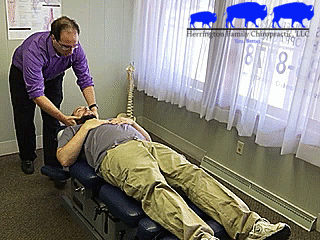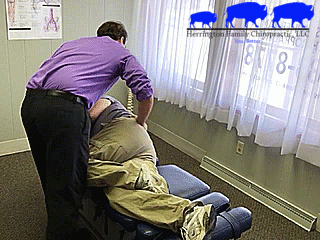What is Chiropractic Manipulation Technique (CMT)?
Chiropractic Manipulative Technique (abbreviated CMT), this form of treatment utilizes an external force from the doctor to the patient’s body. The act of manipulating a joint, or adjusting, is inherently specific for each application. Each adjustment is unique and can vary from region to region, as well as patient to patient, depending on the case at hand. Identifying the right level and location to apply force is a valuable chiropractic skill. This skill is refined through hundreds of hours of practice on the behalf of the chiropractor.
There are hundreds of different types of adjustments and several dozen different styles, all with different uses and different postures. This allows for each practitioner to have a different approach to patient treatment styles, while still obtaining the same effect.
What are the “Pops” and “Cracks” During Adjustments?
Most patients recognize the signature “crack” or “pop” that is audible when they are being adjusted. This sound is properly known as a “cavitation” and is caused by the release of nitrogen gas from the joint capsule of the joint that is being manipulated. This sound is harmless, and is not a required “sound” to a successful adjustment.

Some patients have very audible cavitations, while others make no noise when they are manipulated. The nitrogen gas is a natural byproduct of the production of the fluid within the joint and then the containing joint capsule is stretched, the smaller gas bubbles join into a larger one then collapse. Given enough time, the nitrogen gas permeates the fluid once again. (Approximately 20 minutes)
The Purpose of Chiropractic Adjustments
Most patients recognize the signature “crack” or “pop” that is audible when they are being adjusted. This sound is properly known as a “cavitation” and is caused by the release of nitrogen gas from the joint capsule of the joint that is being manipulated. This sound is harmless, and is not a required “sound” to a successful adjustment.
Some patients have very audible cavitations, while others make no noise when they are manipulated. The nitrogen gas is a natural byproduct of the production of the fluid within the joint and then the containing joint capsule is stretched, the smaller gas bubbles join into a larger one then collapse. Given enough time, the nitrogen gas permeates the fluid once again. (Approximately 20 minutes)
Types of Chiropractic Adjustments
Dr. Herrington has learned several different styles of manipulation and utilizes each of them depending on the situation. Having previous experience with Diversified, Gonstead, Activator, SOT and Cox styles of adjusting, allowed for Dr. Herrington to alter his treatment styles for each individual patient.
Who can benefit from Chiropractic Adjustments?
Chiropractic adjustments can be utilized for a variety of purposes. They quite obviously, mobilize the actual physical joint, but also cause a regional relaxing effect on the muscles. Given this benefit, adjustments can not only be used to therapeutically treat hypomobile joints (joints that are “locked” in place) but also stiff joints that have muscular imbalances associated with them.

Beyond these mobility effects, the adjustment has been shown to cause minor changes in the local neurological pathways as well. In this way, a chiropractor can also have an effect on a variety of other conditions, such as, blood pressure, carpal tunnel syndrome, disc herniations, headaches, scoliosis, pregnancy related pain, radiculopathy, stress disorders and altered spinal curvatures, vertigo and whiplash to name some of the most common.
There is also notable benefit to patients with TMJ or Temporomandibular Joint pain.
Contraindications for Chiropractic Adjustments
While chiropractic adjustments may be beneficial in a large variety of conditions, there are also significant contraindications. Stiffened or atherosclerotic carotid arteries, Aneurysmal Abdominal Aorta, remarkably high blood pressure, Rheumatoid Arthritis (specifically rheumatoid nodules in the cervical spine, with cervical adjustments), Down’s syndrome (with cervical adjustments), general hypermobility conditions (such as Ehler’s Danlos syndrome), Advanced sclerotic conditions (such as Ankylosing Spondylitis), fractures, infections, and bone cancer are some of the most common.
Any and ALL patients that receive treatment at Herrington Family Chiropractic are required to receive a thorough physical examination, with a full medical history, to ensure you are a proper candidate for the treatments offered. If you aren’t a good for the care Dr. Herrington provides, a referral will be given to the best location for your treatment.
Are you experiencing joint, neck, or back pain? Work with a Buffalo Chiropractor that can help you.
Here at Herrington Family Chiropractic, not only does Dr. Herrington excels at spinal manipulation, but is also highly proficient at soft tissue manipulation. Utilizing techniques such as Myofascial Release Technique (MRT), Graston, Soft Tissue Massage, Ultrasound therapy and Low Level Laser Therapy (LLLT) to ensure patients can be effectively treated for all their aches and pains.
If you have been living with joint, neck, or back pain, please contact us to schedule your consult.
